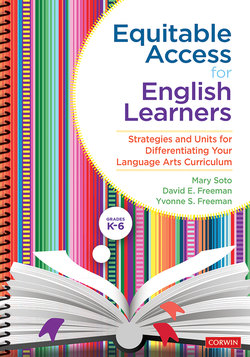Читать книгу Equitable Access for English Learners, Grades K-6 - Mary Soto - Страница 36
На сайте Литреса книга снята с продажи.
Using a Gradual Release of Responsibility Model
ОглавлениеOne way to support reading and writing development for English learners at different levels of language proficiency is to use a gradual release of responsibility model. In this way, students who are less proficient receive more support either from the teacher or a more capable peer as they acquire more proficiency in reading and writing English. In the model below, beginning ELs receive lots of support from their teacher or a more capable peer, and then, little by little, they move toward independence. This model is also recommended for use with students whose home language is English.
The gradual release of responsibility model of reading and writing (Pearson and Gallagher 1983) involves several steps. Effective instruction involves gradually releasing responsibility from the teacher to the student. At first, the teacher performs the task and the student observes and begins to engage with it. Next, the teacher helps the student perform the task. Gradually, the teacher removes the support and releases the responsibility so that the student can complete the task independently. Figure 1.11 shows how the gradual release model is applied to literacy instruction.
Instruction moves from teacher support (the area below the diagonal line) to student independence (the area above the line). As the figure shows, responsibility for reading and writing rests at first entirely with the teacher. The teacher models reading by reading books aloud or telling stories. Read alouds and storytelling model for students how texts are structured and introduce the academic vocabulary and syntax of written language. A teacher models writing by engaging students in language experience as students dictate stories or information. The students can see their oral language being written down, and then the students and the teacher read the writing together.
Description
Figure 1.11 Gradual Release of Responsibility Model
During the next stage, the teacher and students take joint responsibility for reading and writing. In shared reading, teachers often use big books so all the students can see the text. Teachers track the text as they read, and students chime in on predictable repeated sections. Interactive reading and writing may be done with the teacher or with peers. For example, teachers may read a text and have students echo what they read. The teacher may stop at certain sections so a student can continue the reading, and then the teacher may come back in. Interactive reading is often done in bilingual pairs, with one student assisting the other during the reading. During interactive writing, the teacher may sit with the student and help as needed as the student writes, or two students may work together on developing a piece of writing.
For guided reading and writing, the teacher may begin by presenting a mini-lesson to illustrate a particular skill or strategy. In guided reading, the teacher sits with small groups of students who all have a copy of the text. Students take turns reading to practice certain skills, such as predicting or using context to infer the meaning of unfamiliar words. In guided writing, the teacher works with a small group to help with specific writing skills, such as writing a good lead or deciding where to break a text into paragraphs. During guided reading and writing, the students take responsibility to read and write, focusing on certain skills under the teacher’s guidance. The final step is for students to read and write independently. Teachers should allow time for independent reading and writing each day.
